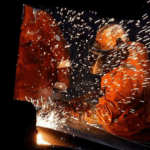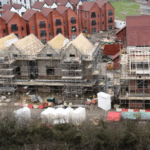In western Germany, a museum dedicated to the Neanderthal is gaining newfound attention, with a surge in visitors since the pandemic. The Neanderthal Museum, located near Düsseldorf in the Neander Valley, is offering an immersive experience that highlights our ancient ancestors in a new light. The museum, which first opened in 1996, has seen a remarkable rise in attendance, with 180,000 visitors in 2023, the highest since its opening. According to museum director Bärbel Auffermann, this year’s numbers are expected to match or surpass that figure.
The museum showcases a blend of realistic models, ancient artifacts, and educational exhibits that trace the history of humankind over millions of years. One of the most striking exhibits features a life-like statue of a Neanderthal, nicknamed “Mr. Four Percent.” The statue, dressed in modern clothing, subtly highlights that many humans today share up to 4% of their DNA with Neanderthals. This reflects the growing body of research showing that instead of being displaced by early humans, Neanderthals interbred with them, leaving a lasting genetic legacy.
The museum’s focus is not just scientific but also on reshaping the image of the Neanderthal. Auffermann explained that for years, Neanderthals were stereotyped as brutish cavemen. The museum aims to rectify this perception, positioning the Neanderthals as complex and sophisticated beings. The site has expanded its offerings in recent years, including a Stone Age-themed playground and a 22-meter “cave view” observation tower. The museum’s efforts to reshape Neanderthal PR have been complemented by an ongoing surge in documentaries and books about the species.
One of the museum’s new exhibits, set to open on November 23, will explore the role of women in Neanderthal society. Accompanying the exhibit is an audio tour narrated by author Rebecca Wragg Sykes, whose book Kindred: Neanderthal Life, Love, Death, and Art has shed light on the emotional and social aspects of Neanderthal life. Sykes points out that recent research, including the sequencing of the Neanderthal genome in 2010, has revolutionized our understanding of the species. “The Neanderthal genome made it clear that they are not a distant, extinct species, but part of who we are,” she said.
The museum’s visitor experience highlights both the Neanderthal’s advanced social structures and the interconnectedness between our species. Life-size figures of ancestors like Lucy, the famed Australopithecus, stand alongside modern Homo sapiens, reinforcing the notion that Neanderthals were not as distant or as “primitive” as once thought.
Today, the museum’s mascot, a statue of a hipster-like Neanderthal affectionately called “Mr N,” continues to draw attention from visitors eager to engage with the past. His popularity has even led to his replacement after his predecessor’s skin wore down from so many visitors touching the figure.
The Neanderthal Museum stands as both a tribute to our ancient cousins and a reminder of how far our understanding of human evolution has come.
















